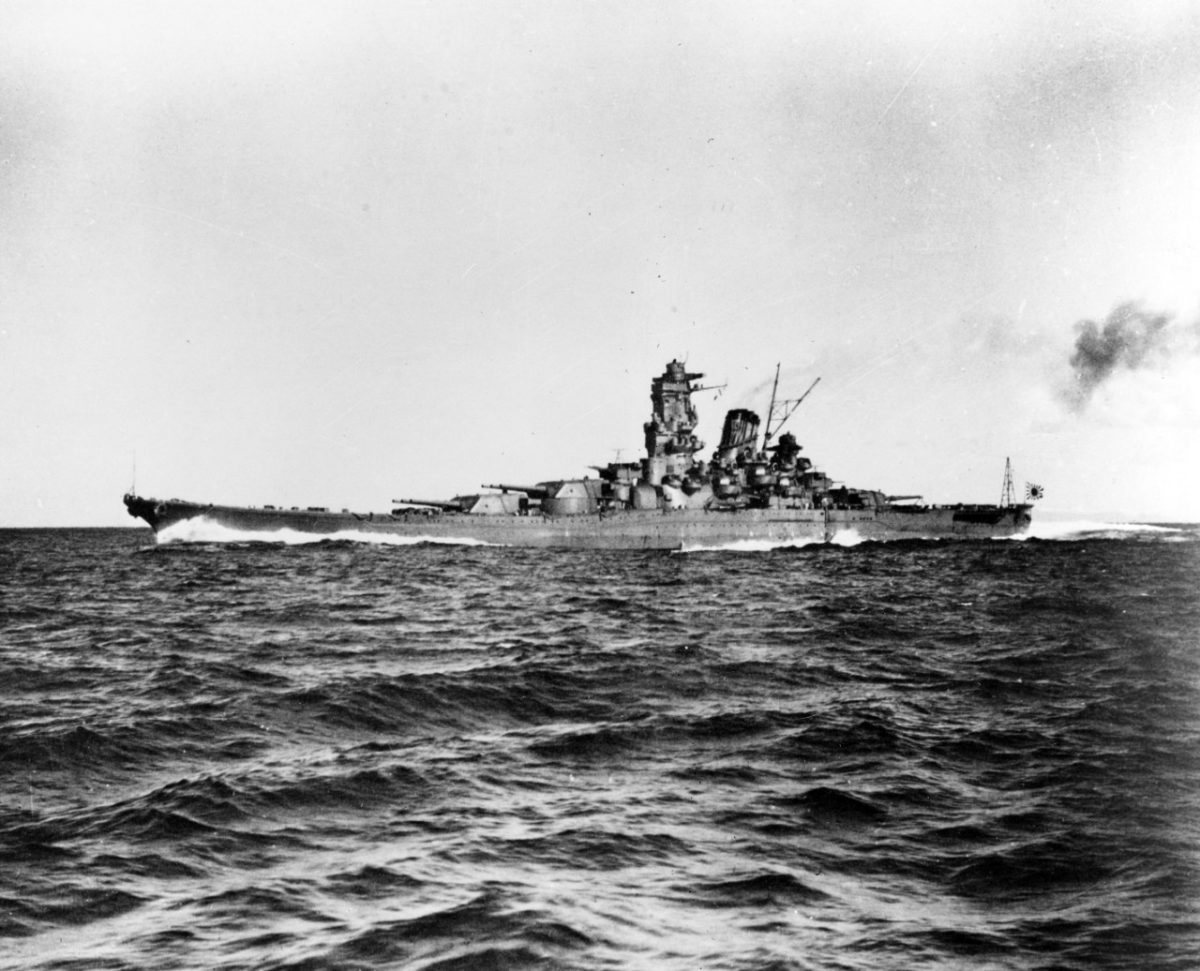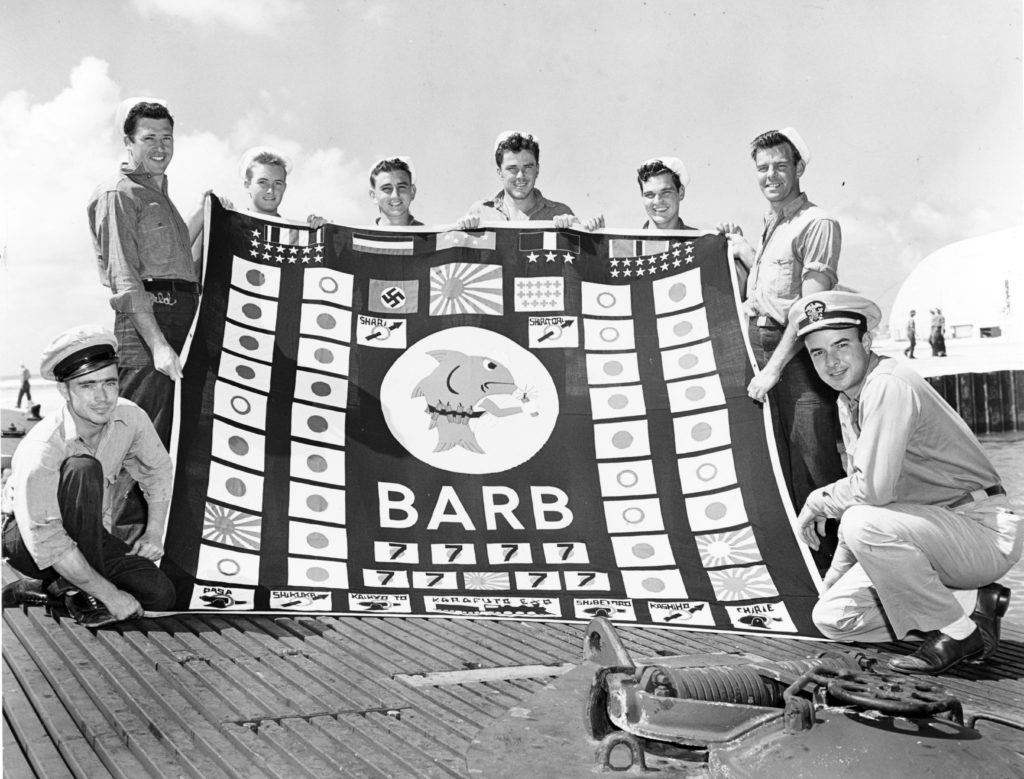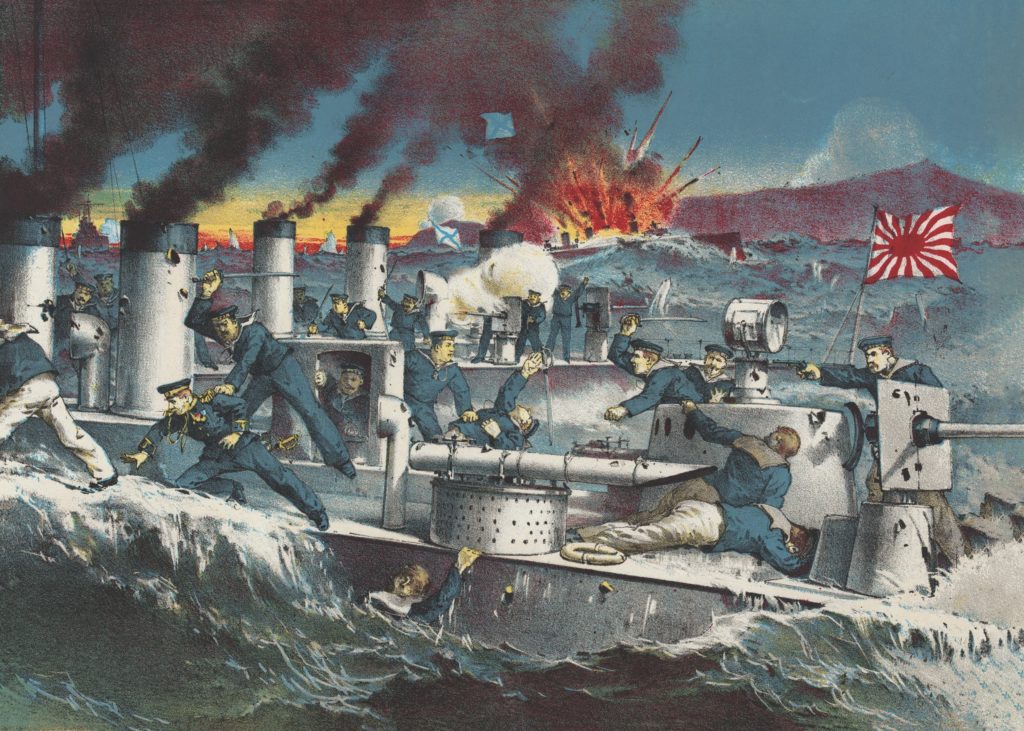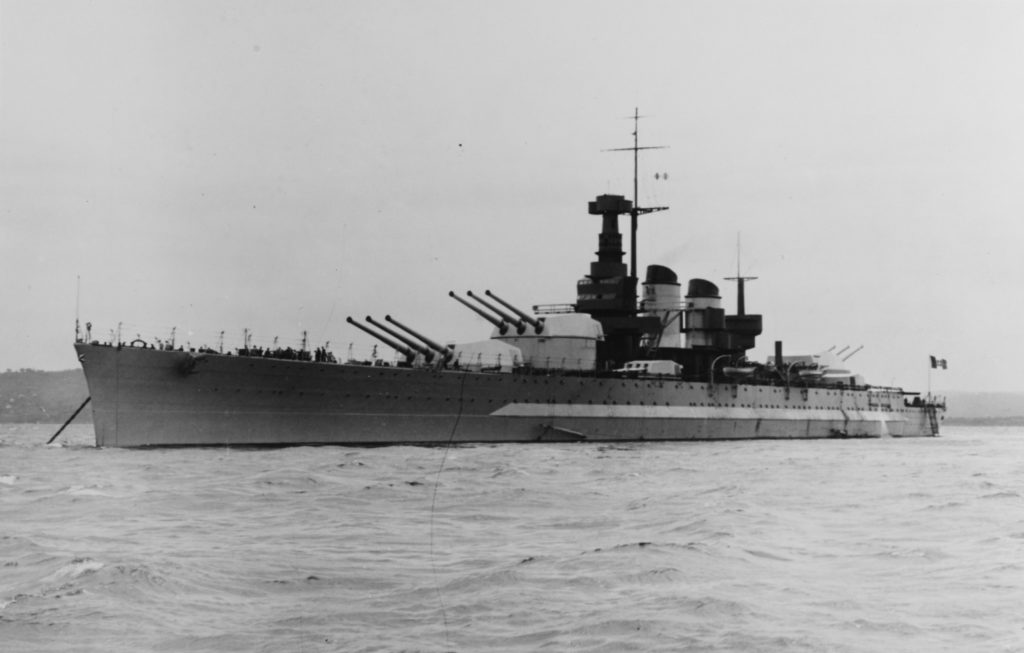The air raid sirens were wailing. Ignoring them, Emperor Hirohito seated himself at the conference table in the shelter adjoining the Imperial Library. The sirens had become a fixture of life in Tokyo. Nearly three weeks ago, on the night of March 10, 1945, American B-29s dropped incendiary bombs on the city. Over 100,000 Japanese perished in the fires, which turned 16 square miles of Japan’s capital into charred rubble. The smoke and stench of the blazes still wafted through the Imperial Palace.
How much longer the reign of Hirohito — or the Empire of Japan — might last was very much on the emperor’s mind. In the past few months, Japan had suffered calamitous setbacks at the Battles of the Philippine Sea, Leyte Gulf, and Iwo Jima. Now, the Americans were about to invade Okinawa.
Recommended for you
At the conference table were the emperor’s military advisers, the chiefs of staff of the army and the navy, and their immediate subordinates. The chiefs had presented to Hirohito the plan for the coming counteroffensive at Okinawa. Occasionally the emperor stopped, squinting through his wire framed spectacles, to ask questions. How many aircraft would be used in the attacks? Two thousand, an admiral told him. Was that enough? the emperor asked. The admiral explained that an additional 1,500 army aircraft would be available.
Hirohito seemed perplexed. Over 100,000 army troops were prepared to die to defend Okinawa, and several thousand kamikaze pilots would be sacrificed. He turned to Adm. Koshiro Oikawa, the navy chief of staff. “And where is the navy?”
Oikawa glanced around him. None of the officers was sure how to answer. Did the emperor understand that the navy had been reduced to a handful of ships? Did he know there was nothing the navy could do to alter the situation at Okinawa?
Perhaps, but it didn’t matter. The emperor’s meaning was clear. It was not acceptable that the army should make so great a sacrifice while the navy’s ships remained clear of the battle for Okinawa. With a single question, the fate of Japan’s greatest warship — and the Imperial Japanese Navy — had been decided.
Yamato departs for Okinawa
Its name was Yamato, the mightiest warship yet constructed. Displacing 71,659 tons and capable of 27 knots, the Yamato possessed the greatest firepower ever mounted on a vessel — more than 150 guns, including nine 18.1-inchers that could hurl 3,200-pound armor-piercing shells on a trajectory of 22.5 miles. Its massive armor was the heaviest ever installed on a dreadnought-class battleship, making it virtually impregnable to the guns of any ship in the world. The very name Yamato was a poetic and spiritual term for Japan itself. In its gray, armored magnificence, the great ship symbolized Japan’s dreams of conquest.
On the morning of April 7, 1945, in response to the emperor’s question — and where is the navy? — the Yamato embarked on its last mission. As the flagship of a force of 10 warships, it would head into the East China Sea in an assault against the American fleet off Okinawa. Codenamed Ten-Go, the operation would coincide with a massive aerial kamikaze assault while the Japanese 32nd Army on Okinawa launched a counterattack on the ground. After inflicting maximum damage on the American ships, Yamato would be run aground and serve as a stationary artillery platform until destroyed. Any remaining crew would join the garrison defending Okinawa.
Almost no one aboard the Yamato, including the officer commanding the operation, Vice Adm. Seiichi Ito, believed it would succeed. Ito at first flatly refused to carry out the order. Not until he was informed that the emperor himself expected him to execute the mission did he accept his fate.
Abuzz of excitement crackled through the flag bridges of the U.S. Fifth Fleet. Aboard the battleship New Mexico, Adm. Raymond Spruance studied the newly received surveillance reports. The Yamato, the last of Japan’s great battleships, was coming out to fight. Seldom had Spruance’s staff seen their boss’s cold, gimlet-like eyes flash with such emotion.
In the U.S. Navy of 1945, Spruance was something of an oddity — a nonaviator whose command included the greatest naval air force ever deployed. But Spruance also commanded a task force of battleships and cruisers whose only duty so far had been the bombardment of enemy shore positions on Okinawa. Now Spruance, a normally cool and analytical old battleship sailor, was drawn by the siren song of a last epic surface battle. He signaled Rear Adm. Mort Deyo, who commanded Task Force 54, to prepare his battle line to meet the Yamato task force. If things went according to plan, the prize of sinking the world’s greatest dreadnought would go to the battleship admirals.
But on the eastern side of Okinawa, aboard the carrier Bunker Hill, the commander of Task Force 58 — the fast carrier task force — was eyeing the same prize. Vice Adm. Marc “Pete” Mitscher had the gaunt, wizened face of a bird of prey; fittingly, his call sign was “Bald Eagle.” Like most senior naval aviation officers, Mitscher had spent a career fighting the battleship admirals who had steered the navy’s thinking for most of the current century. One of those was his immediate superior, Spruance.
U.S. anticipates deciding battle
Mitscher felt a stirring of battleship-versus-aircraft carrier rivalry. Though the carriers had mostly fought the great battles of the Pacific, whether air power alone could prevail over a surface force had not been proven beyond all doubt. Here was an opportunity to end the debate forever.
Now Mitscher had a problem. Spruance had just transmitted an all-fleet order to allow the enemy task force to proceed southward, where Admiral Deyo’s surface task force would engage it. In the meantime, Mitscher’s orders were “to concentrate the offensive effort of Task Force 58 in combat air patrols to meet enemy air attacks.”
Like a team of sharp-eyed contract lawyers, Mitscher and his staff pored over the order, looking for slack. Mitscher had served under Spruance long enough to know his style, and Spruance’s order had not specifically forbidden Mitscher to go after the enemy. It was as much slack as the Bald Eagle needed.
The trick was in knowing where the enemy fleet was headed and what its objective was. Deyo’s 6 battleships, 7 cruisers, and 21 destroyers were already headed north to intercept the Japanese force. Mitscher acted on a hunch that the Yamato was feinting northwestward. If he was right, the Japanese would soon make a hard turn south toward Okinawa. He signaled his carrier task groups to prepare for action.
The race to get the Yamato was on.
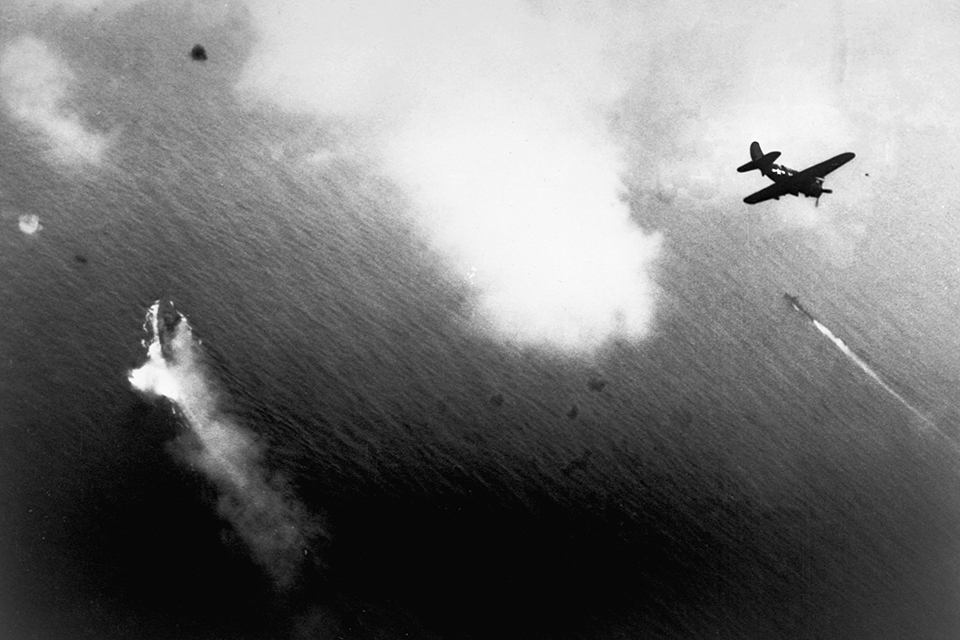
Through the breaks in the low overcast, Ito caught glimpses of the enemy. He could see the American reconnaissance planes flitting in and out of the clouds, tracking his task force. As Ito turned the Yamato task force southwestward, racing toward Okinawa, the weather turned increasingly sour. Veils of light rain were descending like curtains from the clouds to the sea.
At 20 minutes past noon on April 7, the first wave appeared on the radar. Hunched over his scope, the young radar officer Mitsuru Yoshida tried to sort them out. On his screen they appeared as three large blobs, one for each formation. Gradually they resolved into groups, then flights, then individual airplanes.
From the bridge came a flurry of orders. Each ship in the task force increased its speed to 25 knots. The entire formation swung together to an easterly heading. The waiting was over; Yamato’s last fight would be a sea-air engagement, not a surface action against other ships.
‘Commence firing!’
An entire formation of warplanes emerged from a gap in the clouds. One after another they peeled off in a dive. Yamato’s captain, Rear Adm. Kosaku Ariga, barked “Commence firing!” from his command post atop the bridge tower. In the next instant, 24 antiaircraft guns and 120 machine guns opened fire. Thunder reverberated through the steel decks. From across the water came the echoing gunfire of the screening ships. The gloomy sky turned crimson with the explosions of a thousand shells. Ariga was standing out in the open, shouting commands as the first bombs and machine gun bullets rained down on the Yamato. The battleship’s thick armor plate resisted most of the bombs, but shrapnel and bullets sliced through the gun crews like a scythe.
The dive bombers were the hardest to defend against because they were attacking from almost straight overhead. The gunners were having trouble tracking them until the enemy planes had already released their bombs and were pulling out of their dives. A bomb from an SB2C Helldiver wiped out a five-inch gun turret, shredding the bodies of all the gunners. Another bomb exploded into the radar room, killing everyone inside.
The fighters—F4U Corsairs and F6F Hellcats — were attacking in shallow dives, mainly dropping lighter bombs, but their machine guns were raking the ship with deadly precision. The hellish concussion of gunfire, roaring engines, and rattling machine guns beat like a hammer on the flesh of every man aboard the ships.
Off Yamato’s port beam appeared the torpedo planes, looking dark and ominous in the gray murk. As the TBM Avengers swooped in closer, the smaller guns on Yamato joined in the collective defense. One of the torpedo planes took a hit in the wing, pulled up in flames, then plunged into the sea. The others kept coming. Torpedoes dropped from their bellies, slashing through the water toward Yamato.
Deyo had just received a cheery send-off from his immediate boss: “We hope you will bring back a nice fish for breakfast.” Deyo was in the act of scribbling his reply when he was interrupted by an incoming report. Mitscher’s planes had just found the Japanese fleet. Deyo tried to swallow his disappointment. He finished the message with, “… if the pelicans haven’t caught them all.” Deyo had been around the navy long enough to know that some things never changed; given the chance, the damned “airedales” would steal the glory.
Pelicans or not, Deyo was sticking to his orders, taking his battlewagons north. If nothing else, he was going to earn himself a footnote in military history. Morton Deyo would be the last naval commander in World War II — perhaps history — to form a battle line against an enemy fleet.
GET HISTORY’S GREATEST TALES—RIGHT IN YOUR INBOX
Subscribe to our HistoryNet Now! newsletter for the best of the past, delivered every Monday and Thursday.
From the cockpit of his F6F-5 Hellcat fighter, Yorktown air group commander Herb Houck was directing the planes of his group. It was 1:14 p.m., over an hour since the first wave located the Japanese force. Houck’s group was in the third wave.
The operation was supposed to be a coordinated strike, with Task Force 58’s task groups supporting each other. The tactic had been used and refined since the first air battles of the South Pacific. In successive waves, strike groups from each carrier would bear down on the Japanese task force. The fighters were supposed to go first, strafing, rocketing, dropping light ordnance, distracting the enemy gunners while the SB2C Helldivers plunged almost straight down with their heavy bombs. They would be closely followed by the TBM Avenger torpedo planes, which needed all the distraction and diversion they could get when they made their dangerous low altitude runs straight at the enemy ships.
strike groups eye yamato
At least that was the plan. There was nothing coordinated about the frenzied, disjointed air strike on the Yamato force. Each task group had launched its aircraft without waiting its turn. Each strike leader was trying to be the first to hit the target.
The first to locate the Yamato’s task force had been the planes of Task Group 58.1, from the carriers San Jacinto, Bennington, Hornet, and Belleau Wood. Right behind them came the units from Task Group 58.3 and the carriers Essex, Bunker Hill, Bataan, and Cabot. In the third wave, nearly an hour later, appeared the 106 planes of Task Group 58.4 launched from Intrepid, Yorktown, and Langley. (The only group to miss the show was Task Group 58.2, which Mitscher had detached to protect the kamikaze-damaged carriers Franklin, Enterprise, and Yorktown as they limped to a repair facility at Ulithi.)
As each group arrived over the target, the planes had to jockey for position in the narrow band of sky between the ocean and the lowest deck of clouds at about 1,500 feet. The risk of a midair collision was almost as great as the chance of being hit by the enemy. SB2C Helldivers plummeted through any hole they could find in the overcast, sometimes sharing the space with other planes. Some lost sight of their targets in the clouds, then had to make frantic corrections as they broke clear. Radio discipline had vanished, the tactical frequency was a bedlam of excited chatter, pilots yelling out target locations, calling bomb hits, reporting planes going down.
The Japanese ships were zigzagging across the water like rabbits evading hounds. The destroyers, more nimble than the light cruiser Yahagi and the dreadnought Yamato, were the hardest to hit. They were also the most vulnerable, sinking quickly when they took a bomb or torpedo. The destroyer Hamakaze went down within minutes of the first attack. Two more destroyers were trailing black smoke, moving at only half speed. They were maneuvering in a counterclockwise circle around Yamato, adding their guns to the collective fire.
‘san shiki’ a sign for U.S. pilots
For most pilots, it was their first look at the San Shiki (“Type three”) shells fired from the massive 18.1-inch guns. They were monsters, each weighing as much as an automobile and filled with incendiary tubes that burst in a cone toward incoming airplanes. And then the pilots noticed something else peculiar: the antiaircraft fire was exploding in multiple colors. It was a Japanese tactic they had heard about but not seen — each ship’s guns fired a different color to assist the gun directors in spotting their fire.
The use of San Shiki and colored gunfire was a good sign: it meant the enemy guns were probably not radar directed. They were using visual aiming and ranging, and doing a bad job of it. Though they were putting up a storm of antiaircraft fire, the gunners were missing with great consistency. A few unlucky planes were hit, but most eluded the gunfire.
The best news for the American airmen was the absence of enemy fighters. For some unfathomable reason, the Japanese had deployed the task force with no air cover; the Americans could concentrate on the targets without constantly checking their six o’clock for enemy fighters.
Air group commander Houck had already assigned his 12 Avenger torpedo planes, led by Lt. Cmdr. Tom Stetson, to finish off the Yahagi. But Stetson had just gotten a good look at the Yamato. The ship appeared to be listing badly. He radioed Houck that he wanted to split his group and go after the battleship with six of his Avengers.
Houck concurred, ordering Stetson to change the torpedo running depth from 10 feet to 20. The 10-foot depth had been preset to hit cruisers. Going to 20 feet would put the fish below Yamato’s thicker armor plate, right into its exposed lower hull.
One of the pilots, Lt. jg John Carter, was in the last two-plane section. He watched the first four Avengers go in low and fast, dropping their torpedoes in a spread on Yamato’s beam. “As luck would have it,” he recalled, “the big ship was turning to port, thereby exposing the full broadside expanse of her enormous hull to the converging torpedoes.” Carter saw at least three of the torpedoes explode into Yamato’s hull from amidships to the bow. Two hit so close they looked like a single huge explosion.
As Carter began his own run from aft of the battleship, he could see tracers arcing toward his Avenger. He launched his torpedo across Yamato’s curving wake. Pulling away from the target, he tried to shrink into the metal frame of his seat as the ping and clatter of shrapnel hit the Avenger’s skin. But his torpedo had run true, exploding into Yamato’s port quarter.
yamato’s final moments
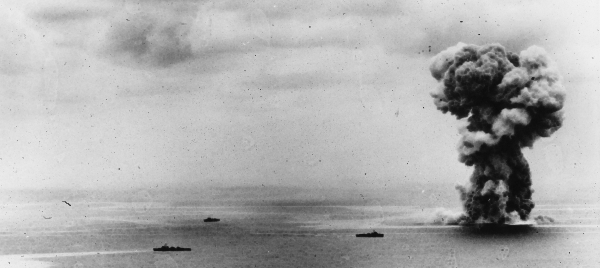
Watching the inclinometer at his command post tilting past 20 degrees, Yamato’s captain Ariga reached an agonizing decision. The battleship’s list to port had become critical. The system of pumps and valves that had flooded the stabilizing compartments and corrected the earlier list was no longer working. The all-important aft water control center had taken a torpedo strike and a direct bomb hit. He would have to flood the starboard outer engine room. Flooding the space would help correct the list, but it would reduce Yamato’s available power. It would also mean certain death for the 300 men in the starboard engine compartments.
In a choking voice, Ariga gave the order. The valves were opened. Seconds later the violent implosion of sea water snuffed out the life of every man in the flooded engineering rooms. The desperate tactic worked, but only for a while. At 2:10, Ariga felt another torpedo slam into Yamato’s stern, jamming its big main rudder hard to port.
Yamato’s death was now certain. The ship could not be steered. The list to port quickly worsened, rolling toward 35 degrees. With its port rail nearly submerged, the ship was locked in a counterclockwise turn. The lofty bridge tower was leaning so steeply that the men in the uppermost decks had to cling to rails and stanchions for support. Reluctantly, Ariga gave the order: “Abandon ship!”
On the sixth deck of the bridge tower, the task force commander, Ito, had already reached the same conclusion. Ito braced himself against the binocular stand and issued his one and only direct command since the battle began: “Stop the operation. Turn back after rescuing the men.” From the beginning Ito had been opposed to what he thought was a senseless sacrifice. Now it was coming to the very end he had predicted. The admiral shook hands with his surviving staff officers, then descended the ladder to his sea cabin one deck below. It was the last anyone saw of Seiichi Ito.
At the captain’s command station, a messenger was helping Ariga tie himself to the compass binnacle. Yamato’s captain intended to go down with his ship, and he was taking no chances that his body would wash to the surface. Meanwhile, the most junior officer on the bridge tower, Ensign Mitsuru Yoshida, was wriggling up through the lookout port toward the top deck. By the time he reached the top, Yamato’s captain had already vanished beneath the water. So had the navigation officer and his assistant, who also tied themselves to their stations. Yoshida could see dozens of crewmen perched like stranded rats on the rust brown belly of the battleship.
The sea rose from beneath them. As water engulfed the ship, men disappeared into the yawning eddies and whirlpools around the sinking hull. Yoshida drew a deep breath and rolled himself up in a ball. For what seemed an eternity, he churned inside the whirlpool, unable to escape, feeling that each of his limbs was being torn from his body.
At that moment — 2:23 in the afternoon — the Yamato exploded. The blast rose like a volcanic eruption. As the fireball dissipated, a black mushroom cloud took its place, billowing a mile into the sky. The smoke was seen by coast watchers over a hundred miles away on the shore of Kyushu.
It was later theorized that Yamato’s 90-degree list caused the shells for its main batteries to slide in their magazine, hitting their fuses and exploding. The eruption sent thousands of pieces of shrapnel into the air, and the rain of debris killed most of the unlucky sailors swimming on the surface. The underwater concussion killed those near the submerged main deck. Swimmers unfortunate enough to be near Yamato’s raked smokestack were caught in the massive suction created by the huge open funnel as the ship went under.
Of the ten warships that had set out with the task force, six were still afloat, but barely. The destroyers Isokaze and Kasumi were shattered hulks, adrift in the East China Sea. Over 4,000 men who had sailed aboard Yamato and its escorts were dead. Of Yamato’s 3,000-man crew, only 269 had been saved. One of them was Ensign Yoshida, somehow thrown from the whirlpool. He would spend the rest of his life wondering why.
gamble pays off for u.s.
With an ever-present cigarette dangling from his mouth, Vice Adm. Marc Mitscher peered at the still-wet photographs from the strike. Killing Yamato and five of its screening ships had not come without a price. Ten warplanes — four Helldivers, three Avengers, and three Hellcats — had been lost. Four pilots and eight aircrewmen were missing and presumed dead. Several had been snatched from the sea by daring search and rescue crews. Still, the losses were miniscule when measured against those of the previous great air-sea battles.
The Bald Eagle’s gamble had paid off. It was all there in the grainy photos — conclusive proof of the warplane’s dominance not only of the sky, but of the sea. The age of the battleship was officially over.
The next day, Deyo and his beloved battlewagons would go back to their shore bombardment duties off Okinawa, and Spruance would return his attention to the bigger picture. The Yamato encounter was dramatic, satisfying, perhaps even historically significant. But the pragmatic admiral knew the truth: the real battle for Okinawa was just beginning.
In Japan, news of the Yamato disaster was withheld from the public. It fell to Navy Minister Mitsumasa Yonai to inform the emperor. With downcast eyes, Yonai stood before Hirohito and reported that Operation Ten-Go had failed.
The emperor seemed not to understand. He peered at Yonai through his spectacles. What about the navy? he asked. What was the status of the fleet? The minister spoke the truth. There was no fleet, he told the emperor.
The Imperial Japanese Navy had ceased to exist.
Robert Gandt is a former naval officer and aviator. His latest book, The Twilight Warriors (Broadway Books, 2010), covers the Battle of Okinawa, the Pacific War’s deadliest air and sea engagement. Gandt lives with his wife in Daytona Beach, Florida. Visit gandt.com.
historynet magazines
Our 9 best-selling history titles feature in-depth storytelling and iconic imagery to engage and inform on the people, the wars, and the events that shaped America and the world.


